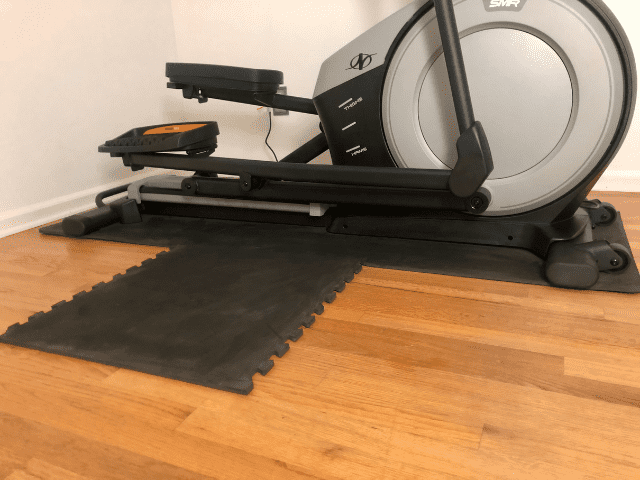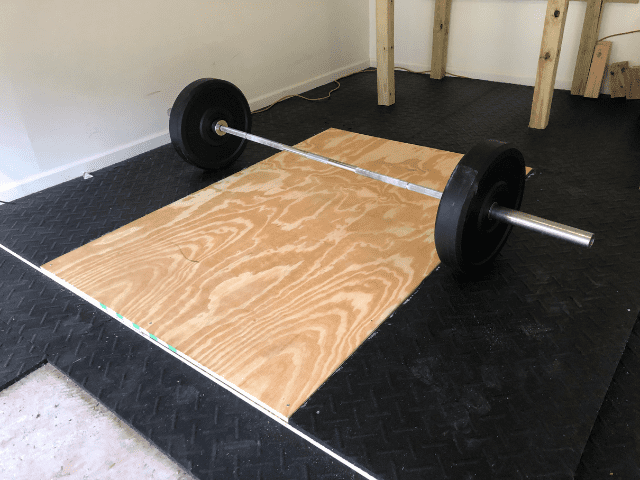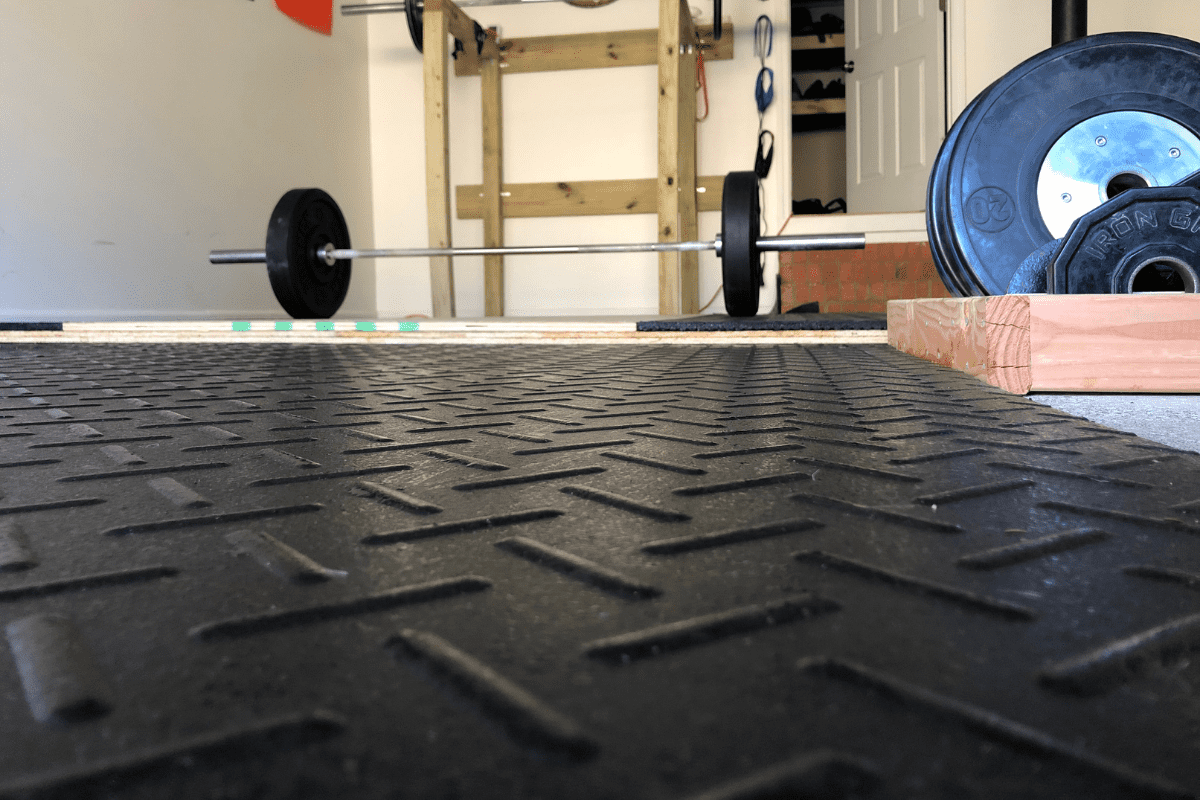Is Gym Flooring Necessary? (Yes, Here’s Why)
As you begin planning out your new home gym space, two things are going to quickly become mortal enemies – the equipment you want and your budget. So, as equipment expenses begin to add up you may start to wonder if gym flooring is really necessary.
Gym flooring, like all gym equipment, is not exactly cheap. Even budget-friendly flooring options are going to cost a couple of hundred dollars to cover the space of a single car garage. That money could easily buy a barbell, some plates or maybe even a bench.
But, before you start reallocating your flooring funds to a new set of dumbbells, here’s the truth:
Gym flooring is absolutely necessary because it protects your floor from scuffs, scratches, dents and even cracks. It also protects your equipment as well from being dropped on a concrete garage floor over and over again.
The return on investment of gym flooring is just too great to ignore. Cutting costs on the front end by bypassing gym flooring can end up costing you 10x that amount if you need to replace a floor and/or an entire set of bumper plates.
Now that we’ve established that you definitely need to opt for gym flooring, the next question is…
What Type of Flooring is Preferred for Home Gym?
The type of flooring that is going to work best for your home gym is going to be heavily dependent upon how you use your home gym. Are you a yoga and resistance bands type of person, a bench press and dumbbells lifter or an Olympic lifting, high-intensity maniac?
This article may contain affiliate links. Making a purchase through one of these links may, at no extra cost to you, earn me a commission.
Home Gym Floor for Light Activities

If you plan to use your gym floor for light activities like yoga, or Pilates, along with maybe some light dumbbells (the ones that come in different colors) and resistance bands then you have a lot more flexibility when it comes to what flooring to purchase.
You could always go with any of the more heavy-duty options that I’ll discuss further down, but it’s not really necessary if you don’t want to go that route.
Interlocking EVA Foam tiles may be the perfect fit for your home gym. These tiles are thick (I recommend either 3/4″ or 1″ thickness) and shock absorbent and will be much nicer to workout on compared to a hardwood floor.
The drawback to EVA Foam tiles is that aren’t nearly as tough and durable as the options that I’ll mention next, but that shouldn’t really be an issue for what you need.
Since the setup I’m describing is most often in a room inside the house (as opposed to the garage or the basement) you also won’t have to worry about the strong rubber smell that may accompany some of the other options.
Home Gym Floor for Moderate Activities
For our purposes here, I’m saying moderate activities are for the person that lifts weights but isn’t slamming them down on the ground all the time. Someone that may squat and bench, but not clean & jerk or drop 400-pound deadlifts on the ground.
Basically, a recreational lifter that enjoys bodybuilding-type workouts.
For your home gym, I think you need a step up from the EVA Foam. I think that type of floor is still going to tear up on you sooner rather than later and then you’ll be right back to buying flooring again.
For this type of home gym, I would recommend rubber flooring around 3/8″ thick. This type of rubber flooring is most often bought in rolls and then rolled out into your gym space. This is typically the most cost-efficient means of using 3/8″ rubber flooring.
You could also find rubber flooring in this thickness as tiles and mats and either of those should work fine as well.
Finally, let’s say you mostly do what I’m describing as ‘moderate activities’, but you also like to deadlift a bit or tend to drop your dumbbells after sets of DB Bench.
I would advise getting one (or more) of the 3/4″ rubber mats that I’m about to discuss in a second and use it as the area where you do your deadlifts and/or dumbbell work. This extra layer of protection can help protect those ‘high traffic’ areas that get more wear and tear.
Home Gym Floor for Heavy Activities

Heavy activities would include Olympic lifting, powerlifting and Crossfit – or anything resembling those three.
If you’re going to demand a lot from your gym flooring, then you need flooring that is going to be thick and durable.
For this type of home gym, I recommend rubber gym mats. Personally, I use 3/4″ horse stall mats from Tractor Supply Company and I would recommend the same to anyone else.
They’re thick, durable and will withstand an absolute beating – protecting your floor and your equipment the whole way. (Thick rubber flooring will also help keep your garage gym warm in the winter)
There are also other 3/4″ rubber mats that you get instead of TSC horse stall mats and those will work just fine as well. The reason I still lean toward the TSC mats is because of the price. They’re sometimes half (or even more) the cost of other rubber mats on the market.
They don’t come without their downfalls as well and number one on that list is their smell. Brace yourself, because these rubber mats will smell awful when you first bring them home, but the smell won’t last and there are some ways you can speed up the process of getting rid of it.
Finally, if you are going to be doing a lot of Olympic lifting, I would highly suggest looking into buying, or building, a platform as well. Dropping a clean and jerk creates a lot of force and adding an extra layer of protection for your floor is definitely worth looking into.
Final Thoughts
Home gym flooring is necessary. Like, super necessary.
Yes, it can be expensive, but so is the floor of your house (whether it’s a room, garage or basement) and so is all the other equipment (like dumbbells for example) you’re going to be buying.
My last piece of advice on gym flooring – buy it nice or buy it twice.
If you get flooring that is designed for what you’re going to be doing on it, you’ll probably never have to buy flooring ever again. I have a friend that runs a training facility using the same stall mats he bought when he opened 10 years ago.
But, if you try to cut corners and buy cheap – or just gym flooring that isn’t meant for your needs, it will tear up and it could tear up way quicker than you would even imagine.

